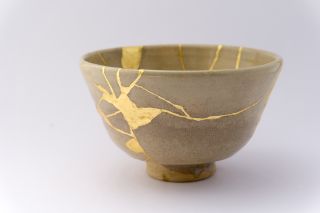Emotional Intelligence
What Kintsugi Can Teach Us About Our Emotional Health
A Personal Perspective: The Japanese art of repairing pottery applied to emotional well-being.
Posted April 2, 2024 Reviewed by Devon Frye

Kintsugi is the Japanese art of repairing broken pottery by mending the breakage with gold or other precious metals. I argue that we can learn a lot about our approach to emotional health from this Japanese art form.
Before understanding how kintsugi can be applied to our emotional health, we must first understand the philosophy behind its application to pottery. Gold, of course, costs substantially more than clay. Why would one repair something of lesser value—something broken, no less—with something of much greater value?
The answer is that, in certain schools of Japanese thought, imperfection is viewed as character. A broken piece of pottery that has been repaired is seen as having character. The repaired fragments of pottery are telling a story—perhaps a celebration got out of hand, devastating news was learned, or news of a marriage or a new baby was delivered, and the pottery slipped to the floor.
The repaired breakages in the pottery, then, tell of a life lived and events experienced—much like the physical and emotional scars that we carry. At this point in Western civilization, bodily scars are seen in much the same light. Scars from a Cesarean section tell of a newborn child. Scars from battle tell of wars won and lost. These physical wounds are typically healed through great care and, if necessary, medical innovations; it may be time to approach emotional wounds in the same manner.
Our emotional health is critical to our holistic health; we cannot be well on the outside without being well on the inside, and vice versa. Applying the principles of kintsugi to our emotional health means understanding that emotional wounds may be a part of our lived experience; without them, we may be more of a blank canvas than a life lived. It means healing our emotional wounds with intentionality and focus; if our strengths are like pottery, then our weaknesses can be, in a sense, healed with gold. Like the Japanese, perhaps we should work to lean into our scars rather than concealing them, letting them shine as beautiful markers of a life lived, of events experienced.
Practitioners of kintsugi would suggest that pottery without breakage lacks use and utility; perhaps it’s also true that life without a diverse spectrum of emotional experiences lacks... life. Protected behind barriers, no adventures, no vulnerability, no heartbreak. Living our best lives may mean taking emotional risks, and taking emotional risks may mean emotional wounds, healed with gold, forming beautiful scars.
References
Badenhorst, P. (2018). Kintsugi and processes of productive damage: The values of embodiment and emotion for antiracism work in education. The Pennsylvania State University.
Harris, O., Lawes, A., Andrews, C., & Jacobsen, P. (2022). Kintsugi—identity change and reconstruction following an episode of psychosis: a systematic review and thematic synthesis. Early Intervention in Psychiatry, 16(7), 689-714.
Princer, M. K. (2022). Putting the Pieces Back Together: Using a Kintsugi-Influenced Directive to Promote Self-Forgiveness and Resiliency in Young Adults with Shame and Guilt.
Santini, C. (2019). Kintsugi: Finding strength in imperfection. Andrews McMeel Publishing.
Scherb, H. K. (2018). The kintsugi metaphor to conceptualize healing and repair after torture and trauma: A training program. Alliant International University.


